Imagine waking up in a space that instantly soothes your senses and invites relaxation—sounds like a dream, right? Grey and beige bedroom ideas have soared in popularity because they combine timeless elegance with calming neutrality, creating a versatile backdrop for any style or personality. These hues are perfect for fostering a peaceful sanctuary where you can unwind after a busy day, making them a favorite choice for modern homeowners seeking both sophistication and serenity.
In this article, you’ll discover a diverse array of grey and beige bedroom ideas that inspire tranquility and style. From minimalist designs to cozy, layered textures, these ideas cater to various tastes and spaces, helping you craft your ideal retreat. Get ready to transform your bedroom into a calming oasis with practical tips and gorgeous inspiration—your perfect serene sanctuary awaits!
1. Soft Grey Walls with Warm Beige Accents for a Cozy Atmosphere
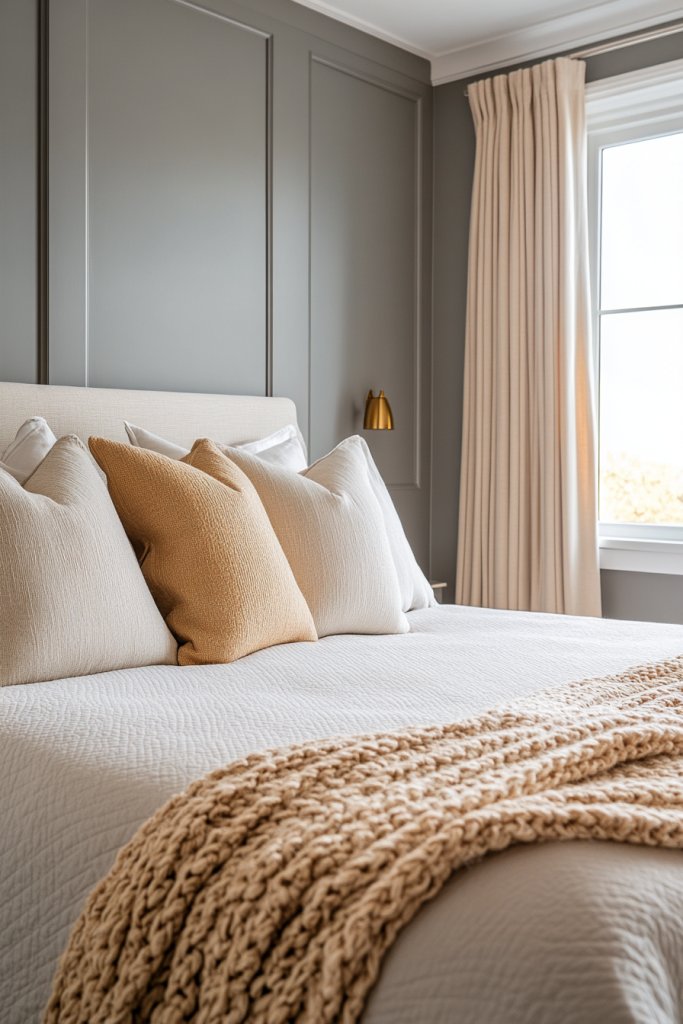
Ever feel like your bedroom lacks that warm, inviting vibe that makes you want to sink into bed and never leave? Sometimes, all it takes is the right color palette to turn a cold space into a cozy retreat. Grey walls paired with beige accents create that perfect balance of calm and warmth, making your room feel like a hug. If your current setup feels sterile or uninspiring, this simple switch might be just what you need.
Imagine walking into a bedroom painted in a soft, light grey that reflects gentle daylight. Beige bedding with plush throw pillows adds texture and invites touch. Subtle accents like a beige throw blanket or a woven basket in natural fibers complete the scene, creating layers of comfort. The neutral tones blend seamlessly, giving the space a serene, timeless look that’s easy to update with seasonal accessories or decorative touches.
You can warm up the grey walls further with hints of taupe or greige, especially in colder months. For a more vibrant look, introduce textured textiles like a chunky knit blanket or velvet cushions in beige hues. If space is limited, keep the palette minimal with just a few accent pieces; for larger rooms, go bold with a feature wall or layered shades of grey and beige for depth. These colors also adapt well to different lighting conditions, from natural sunlight to soft evening glow.
Start by selecting a calming grey paint, like dove or stone, then choose beige textiles—think bedding, curtains, or rugs—that complement. Use a high-quality matte or eggshell finish for walls to avoid glare and add warmth. Incorporate beige-toned accessories such as plush cushions, throws, or even furniture like a beige upholstered headboard or side table. Keep the color scheme consistent for a cohesive look. Light-colored wood or rattan furniture enhances the natural, cozy vibe without clashing with the palette. Lastly, add layered lighting—warm white bulbs or soft lamps—to enhance the warm tones at night.
Personalize by adding your favorite textures—like linen, silk, or faux fur—to create visual interest. Incorporate decorative elements in beige, such as a woven wall hanging or a textured rug, to add dimension without overwhelming the space. Experiment with subtle metallic accents like brushed nickel or warm bronze in fixtures or hardware to elevate the look. You can also swap out textiles seasonally—think cozy wool throws in winter or light linen in summer—for ongoing freshness.
This color combo proves that simplicity can be stunning and versatile. It’s a foolproof way to create a relaxing sanctuary that adapts to any style, from minimalist to boho chic. Once you see how these shades transform your space, you’ll feel confident experimenting with different textures and accessories. The best part? This look is timeless, so it’ll stay in style for years to come, making your bedroom both stylish and serene.
2. Layered Textures with Knitted Throws and Linen Bedding in Neutral Tones
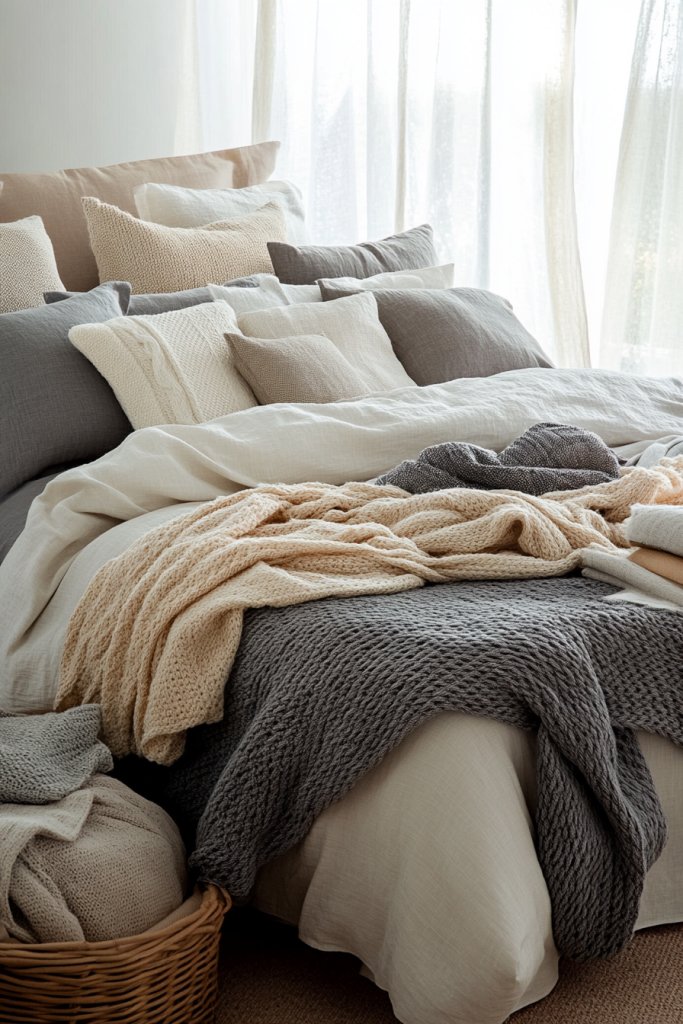
Ever walk into a room that looks nice but feels flat and uninspired? Flat color schemes are great, but they can sometimes lack that cozy, inviting vibe that makes you want to stay. Layering textures is like giving your bedroom a personality boost—adding depth, warmth, and a tactile richness that makes the space feel alive. If your space feels sterile, this approach might be just what you need to turn it into a comforting haven.
Picture a bed dressed in soft linen sheets in shades of beige or light grey, topped with a chunky knitted throw in a matching neutral tone. Layered pillows with varying textures—smooth silk, woven cotton, or faux fur—bring tactile interest. A plush, textured rug on the floor invites barefoot walks and adds warmth underfoot. The combination of rough knit, smooth linen, and plush accents creates a layered, cozy aesthetic that’s both elegant and inviting.
Switch out knitted throws for faux fur or velvet during colder months for extra warmth, or opt for lightweight cotton or silk for summer. Mix and match textures to suit your mood or style—think ruffled linen, quilted blankets, or woven baskets. You can keep the color palette simple, focusing on various shades of grey and beige, or add subtle pops of color through accessories. This approach works equally well in small or large bedrooms, making the space feel curated and personalized.
Start with high-quality linen bedding in neutral tones, ensuring it’s breathable for comfort. Add a chunky knit throw blanket in a matching or contrasting neutral hue, placing it at the foot of the bed for visual weight. Layer pillows of different sizes and textures—think velvet, linen, and faux fur—to create depth. Incorporate a textured rug or layered mats to add softness and warmth to the floor. When decorating, stick within your color scheme, and don’t shy away from mixing textures for added interest. Keep textiles tidy and well-maintained, washing and fluffing regularly for longevity.
Custom touches like embroidered pillowcases or handwoven throws can make your bed unique. Use different textures to highlight your personality—like a fringed throw for boho vibes or sleek silk for modern elegance. Incorporate decorative cushions with varied weaves or patterns to add visual interest without overwhelming the space. Layering textiles also allows you to change the look seasonally, keeping your bedroom feeling fresh and cozy year-round.
Layered textures create a tactile sanctuary that invites relaxation and comfort. This method is easy to personalize—mix different textiles until it feels right for you. Once you experience the cozy ambiance, you’ll be inspired to experiment further with textures and patterns. Remember, the goal is a space that feels inviting and authentic, and layering makes that effortless and fun.
3. Minimalist Furniture in Matte Grey with Beige Upholstered Bed Frame
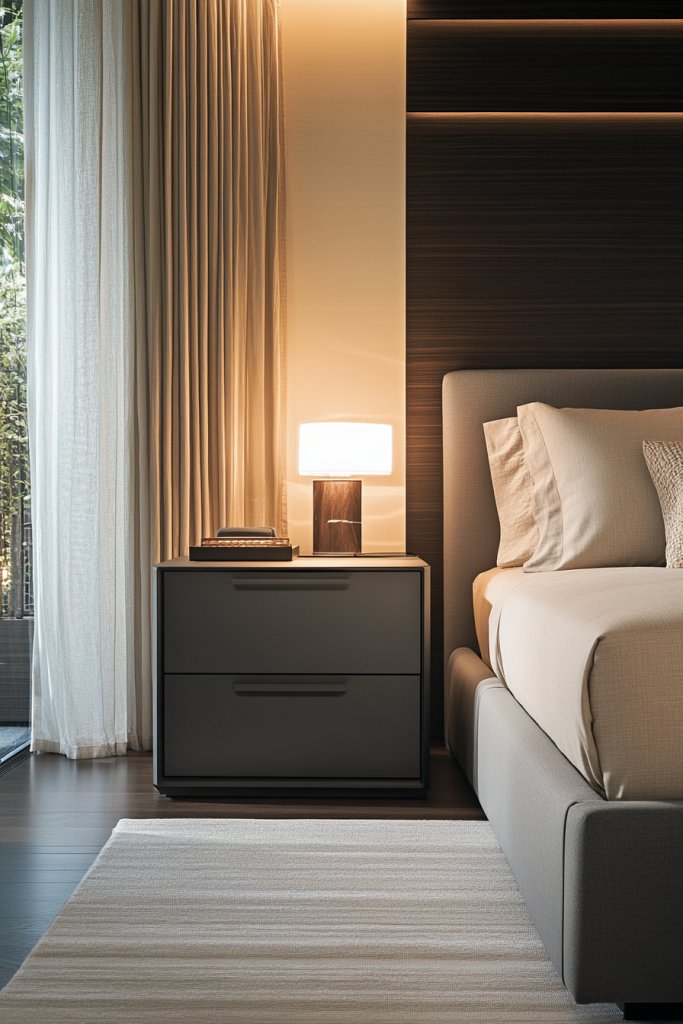
Feeling overwhelmed by cluttered furniture and busy decor? Sometimes less truly is more, especially in a bedroom meant for rest. Minimalist furniture in matte grey paired with a beige upholstered bed frame creates a sleek, distraction-free environment. This look focuses on clean lines and subtle elegance, helping you unwind mentally and physically. If your current setup feels chaotic or overly decorated, this style might be your ticket to calm.
Imagine a bedroom with a matte grey bed frame that has no ornate carvings or excessive detailing, paired with matching minimalist side tables. The beige upholstery on the headboard adds softness and comfort without visual clutter. A simple, streamlined dresser and storage units keep the room feeling open and airy. Natural light filters through unobtrusive blinds, highlighting the matte finish and clean design, making the space feel calm and modern.
You can adapt this look by choosing different shades of grey—cool or warm—to suit your preference. For a softer vibe, opt for a beige or taupe upholstered headboard; for a more striking look, go darker with charcoal. Incorporate sleek, low-profile furniture that emphasizes horizontal lines and avoids bulkiness. This style works well in small rooms by maximizing floor space, but it’s equally stunning in larger settings for a modern, uncluttered aesthetic.
Choose a bed frame in matte grey with a simple rectangular shape, avoiding ornate details. Select a beige upholstered headboard with a foam core for extra comfort during late-night reading. Keep other furniture pieces streamlined and in neutral shades—think flat-front dressers or floating shelves. Use concealed storage options to reduce visual clutter. Finish with minimal accessories—perhaps a single decorative pillow or a plain rug—and ensure lighting is subtle, like wall-mounted fixtures or hidden LEDs. Regularly declutter to maintain the minimalist ethos.
Add personal touches with textured throws or subtle accent pillows in neutral shades. Incorporate sleek, sculptural lamps or sconces that complement the matte finish. Use architectural details like built-in niches or floating nightstands to keep surfaces clear. Keep decor minimal but meaningful—like a simple ceramic sculpture or a geometric mirror—highlighting quality over quantity. This approach encourages a clutter-free mindset, making your space easier to maintain.
Minimalist furniture isn’t just about aesthetics; it’s about creating a peaceful, functional retreat. Once you see how a clutter-free space improves your mood, you’ll be motivated to stick with simple, elegant choices. This style aligns with current trends favoring clean lines and understated luxury, giving you confidence in your design decisions. It’s a timeless approach that balances beauty and practicality, perfect for a restful bedroom sanctuary.
4. Use of Light Beige Curtains to Diffuse Natural Sunlight
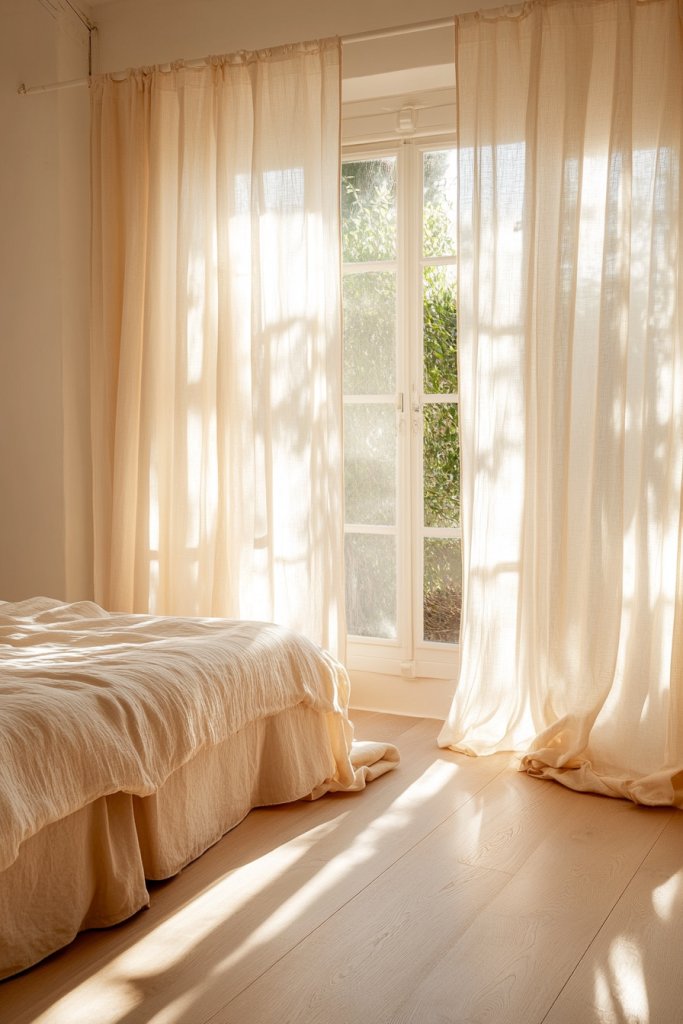
Do your curtains block too much sunlight, making your room feel dark and gloomy? Or do they let in harsh light that disrupts your sleep? The right curtains can transform your bedroom ambiance, balancing light and privacy effortlessly. Light beige curtains are perfect—they filter sunlight softly, creating a warm, inviting glow. If you crave a space that feels bright yet cozy, this simple upgrade can make an immediate difference.
Visualize sheer, light beige curtains hanging delicately from a slim rod, softly diffusing sunlight that spills into the room. The fabric gently sways with the breeze, casting a warm, golden hue during the day. When closed, they provide privacy without darkening the space completely. The neutral tone blends seamlessly with wall colors and bedding, enhancing the room’s calm, airy atmosphere. The subtle texture of the fabric adds depth without visual noise, making the space feel light and tranquil.
For a more layered look, pair sheer beige curtains with heavier drapes in a matching or complementary shade. Use blackout curtains behind sheer panels for sleeping ease while maintaining daytime brightness. In smaller rooms, slim profiles or rod pocket styles prevent visual bulk, keeping the room feeling open. For a boho or relaxed vibe, choose fabrics with a slightly textured weave or a linen finish, adding tactile interest. During different seasons, consider swapping lighter fabrics for warmer, insulating options for winter.
Select curtains in a light beige shade, preferably in a breathable, semi-sheer fabric like linen or voile. Mount a slim curtain rod close to the ceiling to maximize height and make the room appear larger. Install the rod just above the window frame for a clean look. Use brackets that allow for easy removal and cleaning. For added privacy, layer with a second set of thicker curtains or blinds. Ensure the length just grazes the floor or puddles slightly for a luxe feel. Regularly wash or dry clean curtains to keep them looking fresh and light.
Add decorative tiebacks or fabric bands in contrasting textures or subtle metallic accents to customize the look. Incorporate subtle trims or embroidery for a bespoke touch. Mix and match with other soft textiles like throw pillows or bedsheets in similar neutral tones for a harmonious palette. For a cozy winter upgrade, add a thermal lining or heavier fabric, and in summer, opt for breezier linen options. Keep your curtains clean and wrinkle-free to maintain their soft, inviting appearance.
Soft, diffused light makes any bedroom feel instantly more welcoming and restful. Once you see how well light beige curtains enhance the space, you’ll be eager to experiment with layering or textures. This simple upgrade can also improve your sleep quality by reducing harsh glare. It’s a small change with a big impact, giving you confidence to refine other details in your room for a perfect sanctuary.
5. Incorporating Subtle Patterned Bedding in Grey and Beige for Visual Interest
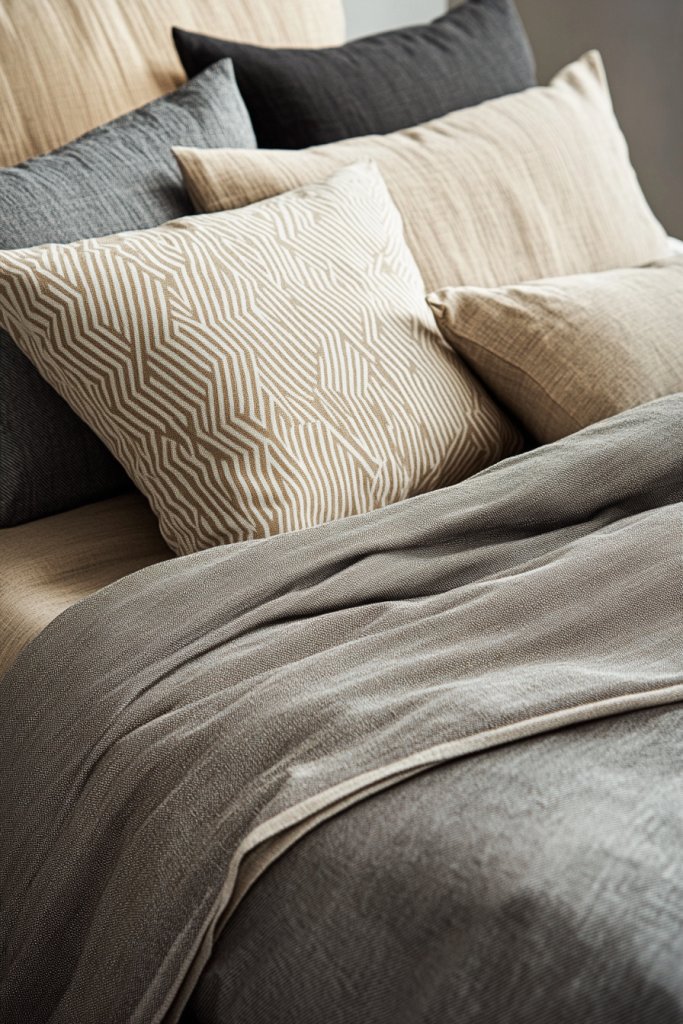
Is your bedroom looking a little too plain, missing that punch of personality? Flat, solid bedding can sometimes make a space feel dull, even if the color palette is soothing. Introducing subtle patterns adds just enough visual interest to elevate your decor without overwhelming the calm vibe. If you want to create a space that feels both relaxing and stylish, patterned bedding in grey and beige might be exactly what you need.
Picture a duvet cover with tonal stripes, delicate geometric designs, or soft abstract prints in shades of grey and beige. The patterns are subtle enough to blend seamlessly with the overall color scheme but add depth and texture. Mix in matching or contrasting pillowcases with similar patterns or textures to create a layered look. The bedding’s gentle patterns catch the eye softly, making the bed the focal point without disrupting the room’s serenity.
Choose patterns that are small and understated for a minimalist aesthetic, or go slightly larger for more visual impact. Combine different patterns—like stripes with tiny geometric prints—in complementary shades for a curated, layered effect. During seasonal changes, switch to lighter or darker tones within the same pattern family to keep things fresh. For added depth, introduce textured fabrics like jacquard or quilted designs that add tactile interest while maintaining subtlety.
Start with a neutral base—think a grey or beige duvet cover in a soft, durable fabric like cotton or linen. Add patterned pillow shams or a bed runner that echoes the bedding pattern but in a slightly different shade or motif. Use a fitted sheet in a solid matching color to keep the look cohesive. Keep the overall palette simple and avoid mixing too many patterns to prevent visual clutter. Regularly wash and re-fluff your bedding to keep the patterns crisp and fresh.
Personalize by choosing patterns that reflect your style—geometric for modern, floral for romantic, or abstract for artsy vibes. Incorporate embroidered or textured throws in coordinating shades for extra dimension. Mix textures with your patterns—think a quilted cover with smooth pillowcases—to create visual contrast. Don’t be afraid to layer different shades of grey and beige in your patterns for a nuanced, layered effect that’s uniquely yours.
Subtle patterns add just enough visual interest to keep your bedroom lively without sacrificing tranquility. Once you see how they elevate your space, you’ll want to experiment with different motifs and textures. This approach proves that small details can make a big difference, inspiring you to refine your entire decor with confidence. The key is balance—let the patterns complement your overall serene aesthetic while adding personality.
6. Floating Nightstands in Soft Grey with Minimalist Design
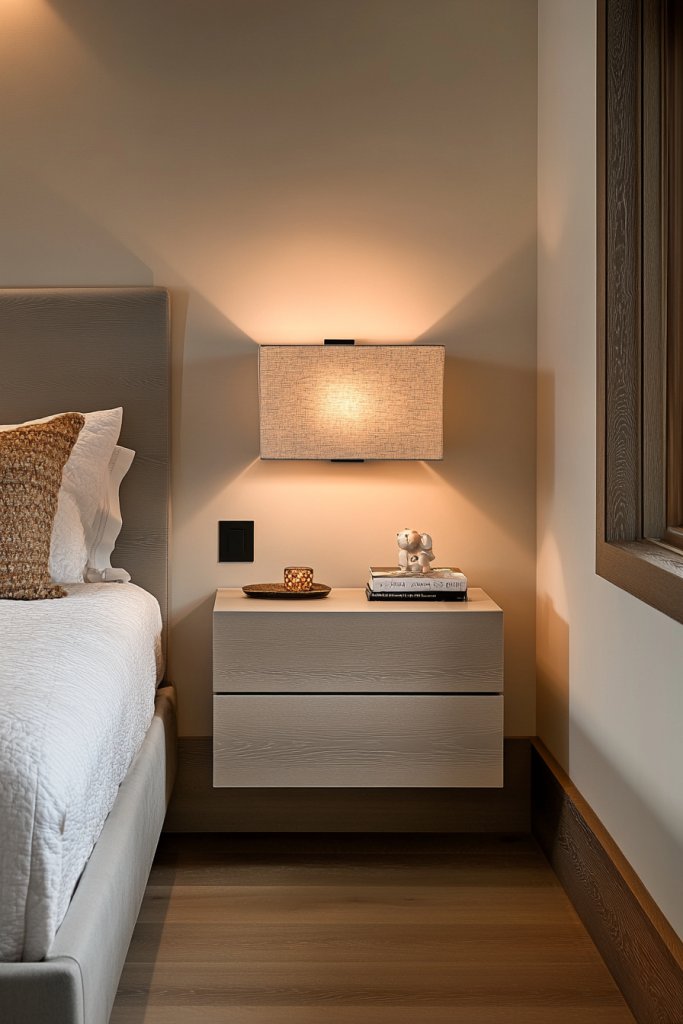
Cluttered nightstands can make your bedroom look chaotic and cramped. If you’re craving a cleaner, more spacious feel, floating nightstands are a game-changer. They free up floor space, create a sleek modern look, and make your room feel open and airy. Plus, they’re super easy to keep tidy—no hidden corners collecting dust. If you’re tired of bulky furniture blocking your view, this minimalist solution might just be your new best friend.
Visualize a softly rounded floating nightstand in matte grey, seamlessly attached to the wall beside your bed. Its minimalist design features a single open shelf or a small drawer, keeping essentials close but out of sight. The clean lines and lack of visible hardware make the space feel uncluttered, especially when paired with a matching headboard or wall-mounted reading light. The floating effect creates the illusion of more space, letting your bedroom breathe and feel more expansive.
Choose floating nightstands with a matte finish in shades of grey that complement your wall color or bedding. For added functionality, opt for models with integrated charging ports or hidden compartments. In small rooms, keep the design simple and minimal to maximize the sense of space; in larger rooms, you can select slightly larger or more decorative floating units. They work well with various decor styles—from ultra-modern to Scandinavian minimalism—and can be customized with different drawer pulls or open shelves.
Start by measuring your bed height and available wall space to select appropriately sized floating nightstands. Mount them securely into wall studs using quality brackets and hardware—don’t skimp here, or you’ll wake up with a mess. Choose a finish that matches or contrasts subtly with your wall or bedding, like a matte grey that blends into a modern aesthetic. Keep the surfaces clear of clutter by adding minimal accessories like a small clock or a decorative box. Regularly check the mounts for stability and wipe down the surfaces for a pristine look.
Add small decorative touches like textured trays or sleek storage boxes to organize essentials. Personalize by choosing floating units with unique shapes—like hexagonal or asymmetrical designs—that add visual interest. Incorporate soft textiles like a cozy throw or a plush cushion on the bed to balance the sleekness of the floating furniture. You can also experiment with lighting—install LED strips underneath for a subtle glow or mount small sconces for direct light—without cluttering the nightstand surface.
Floating nightstands are proof that simplicity and functionality can go hand in hand. They open up your space and make your bedroom feel more modern and serene. Once you see how much cleaner and more spacious your room appears, you’ll be motivated to adopt more streamlined decor choices. This effortless upgrade boosts your confidence in minimalist design—proof that less is often more—and encourages ongoing room refreshes.
7. Beige Area Rug with Grey and Cream Accents to Anchor the Room
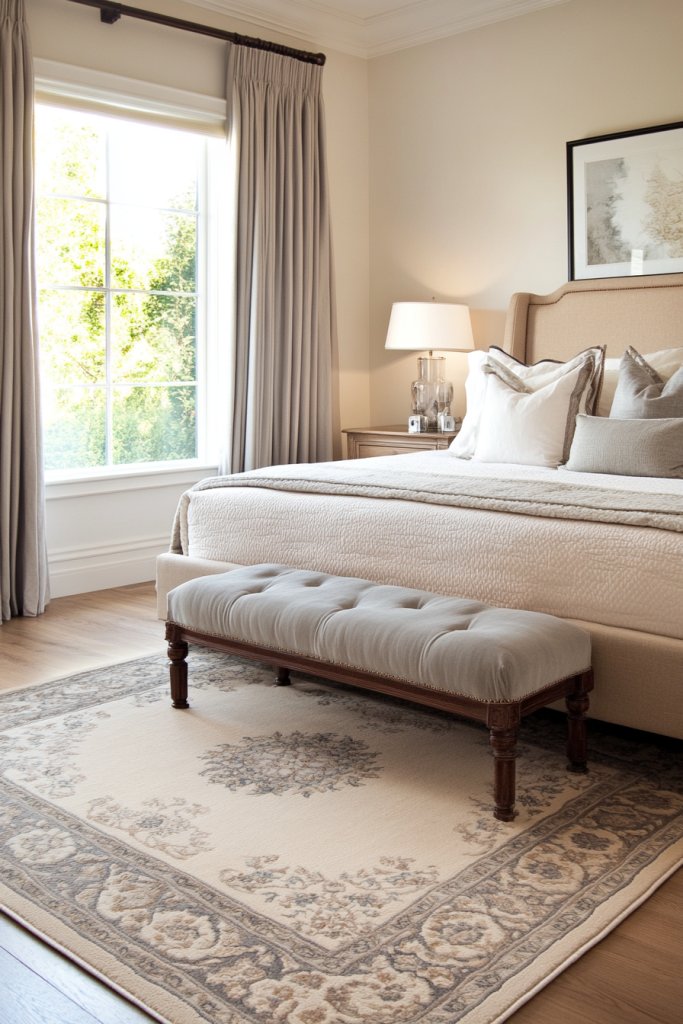
Does your bedroom lack that cozy, anchored feeling that makes it a true retreat? Sometimes, all it takes is a well-placed rug to tie everything together. A beige area rug with grey and cream accents adds warmth, texture, and visual cohesion to your space. If your room feels disjointed or too plain, this simple addition can create an inviting foundation that makes everything feel more complete.
Imagine a plush beige rug spread across the floor, with subtle grey and cream geometric or abstract patterns that complement your bedding and walls. The softness underfoot invites you to walk barefoot and adds a layer of comfort. The neutral tones blend seamlessly with your existing decor, grounding the space and making it feel balanced. The layered tones add visual interest without clashing, creating a sophisticated, unified look.
Select a rug with a pattern that suits your style—be it modern, boho, or classic—while keeping within the neutral palette. For smaller bedrooms, a runner or a smaller accent rug can define a space, while larger rooms benefit from a full-floor rug to unify the design. Mix textures by choosing a shaggy, looped, or low-pile rug depending on your preference for comfort or ease of cleaning. During winter, layer with a sheepskin or faux fur for extra warmth and luxury.
Pick a rug size that fits your room proportionally—about two-thirds of your bed width is a good rule of thumb. Opt for high-quality fibers like wool, nylon, or polyester that are durable and easy to maintain. Lay the rug flat, ensuring it’s smooth and free of wrinkles. Place it strategically under the bed, leaving a border visible on all sides for balance. Clean regularly with a vacuum, and spot clean stains promptly to keep the pattern crisp and colors vibrant.
Add a textured throw or basket in coordinating shades to enhance the layered look. Use accent pillows in grey or cream on your bed that echo the colors in your rug for harmony. Personalize further by choosing a rug with a subtle pattern or unique weave that reflects your personality—think artisanal or vintage-inspired designs. Rotate or switch out rugs seasonally to keep your decor feeling fresh and engaging.
A well-chosen rug anchors your bedroom, making it feel more polished and complete. Once you see how this simple addition transforms your space, you’ll be inspired to explore different textures and patterns in other decor elements. A beautiful rug not only enhances aesthetics but also adds comfort and warmth, turning your bedroom into a true sanctuary. It’s a small change that offers big style and cozy vibes.
8. Incorporating Light Beige or Grey Bedding with Layered Pillows
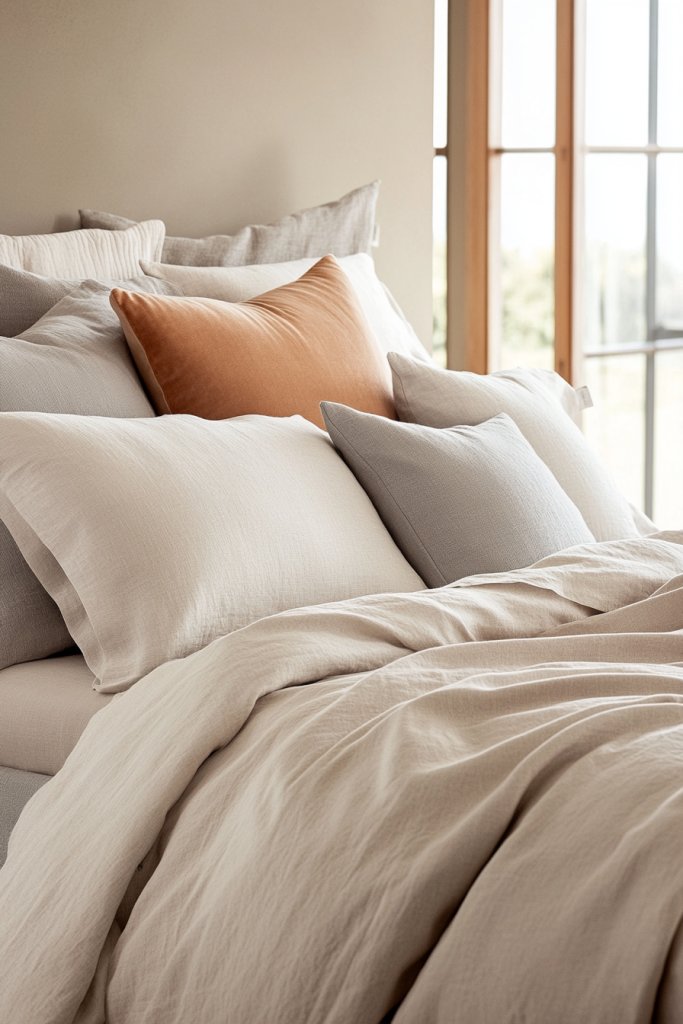
Ever wake up feeling like your bed is missing that inviting, plush look? Flat bedding can make a bedroom feel dull and uninspired. Layering pillows and bedding in shades of grey and beige creates a cozy, hotel-like vibe that screams comfort. If your current setup feels too plain or flat, this simple technique can instantly elevate your sleep space and make it more welcoming.
Visualize a bed dressed in crisp, light beige sheets topped with a textured duvet in a matching neutral tone. Plush pillows in varying sizes—some in smooth fabric, others with textured weaves or subtle patterns—are layered for depth. A few accent pillows in grey or with subtle metallic accents add a touch of sophistication. The overall look is harmonious yet rich in textures, inviting you to sink in and relax. The layered approach adds dimension and makes the bed a focal point.
Mix different pillow shapes and textures—square, rectangular, or bolsters—for visual interest. Play with subtle patterns or embroidery for added personality, but keep within your neutral palette to maintain calm. Switch pillow covers seasonally—wool or velvet in winter, linen or cotton in summer—for fresh vibes. You can also add a textured throw blanket at the foot of the bed for extra comfort and style.
Start with high-quality, breathable sheets in beige or grey, ensuring they’re soft and durable. Layer in several pillows—at least four or five—using cases in complementary textures and shades. Use pillow inserts of varying firmness to create a plush, inviting look. Keep the bedding crisp by regular washing and fluffing. For added visual impact, consider a quilted or embroidered duvet cover, and always ensure the bedding coordinates with your overall room palette. Tucking in sheets and smoothing creases enhances the polished look.
Add decorative pillowcases with subtle embroidery, fringe, or piping for a bespoke touch. Incorporate metallic or textured pillow shams for a luxe feel. Customize by choosing patterns or finishes that reflect your personality—like botanical motifs or geometric designs. Use a matching or contrasting throw in textured fabrics to complete the layered look and add tactile richness. Small personal touches make the bed feel curated and uniquely yours.
Layered bedding not only looks inviting but also promotes restful sleep by creating a cozy cocoon. Once you experience the plushness and visual richness, you’ll be motivated to experiment with different textures and colors. This approach proves that comfort and style go hand in hand, boosting your confidence to create a bedroom that’s both beautiful and functional. It’s a simple upgrade with a lasting impact.
9. Creating a Faint Ombre Effect on Walls from Grey to Beige
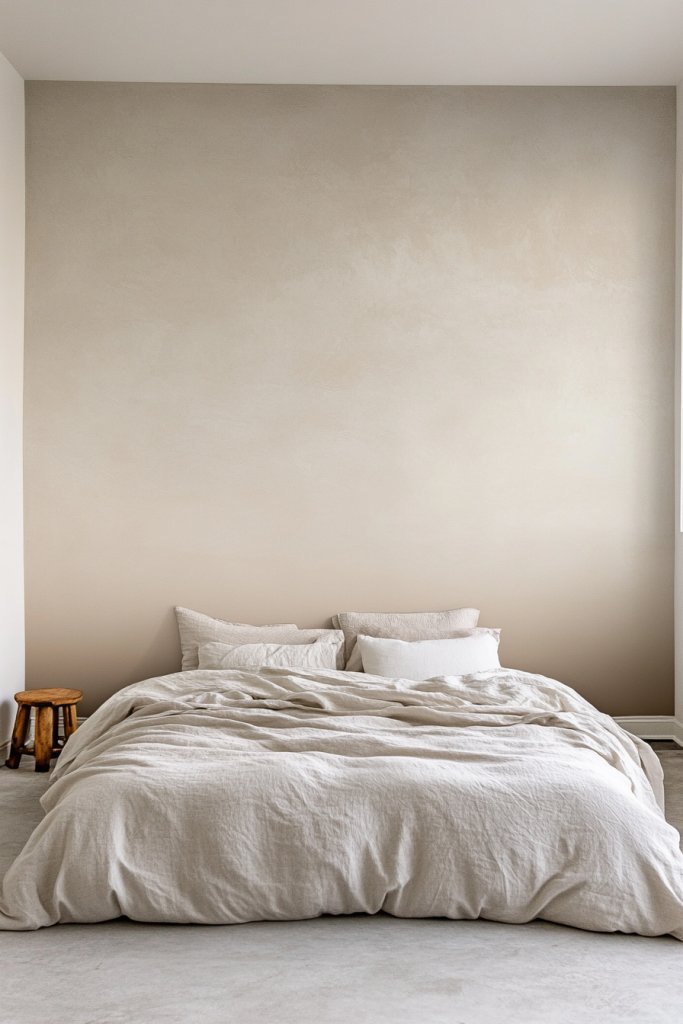
Bored with plain, flat walls that do nothing for your decor? Want to add a subtle, artistic touch that still feels calm and sophisticated? An ombre wall in shades of grey fading into beige creates a gentle focal point that adds depth without overwhelming the senses. This effect can make your bedroom look more dynamic and personalized while maintaining that tranquil vibe you crave.
Visualize a wall where the paint transitions seamlessly from a cool grey at the top to a warm beige at the bottom. The gradient is soft and subtle, almost like a watercolor wash, giving the wall a gentle movement. The effect catches the light differently throughout the day, creating an ever-changing backdrop for your room. It’s understated but impactful, adding a layer of artistic sophistication that elevates the entire space.
Experiment with different gradient intensities—more dramatic or very subtle—to suit your taste. Use high-quality paints designed for blending or hire a professional for a flawless finish. For smaller walls, consider a vertical or horizontal ombre; in larger spaces, full wall coverage creates a bold statement. Combine with textured finishes or matte paints to enhance the softness of the gradient and avoid glare.
Prepare the wall by cleaning and priming it thoroughly. Use painter’s tape to mark the gradient line or a gradual blending zone. Mix your paints in a gradient ratio, adding small amounts of beige to grey or vice versa, and blend with a sponge, roller, or airbrush for a seamless transition. Work in sections, feathering the edges with a dry brush or sponge to create a soft fade. Allow plenty of drying time between coats, and finish with a matte topcoat for durability. Practice on a test patch first to perfect your technique.
Frame the ombre wall with minimalist decor—like floating shelves or simple artwork—keeping the focus on the wall’s gradient. Add ambient lighting that highlights the transition, such as LED strip lights or wall-mounted fixtures. Use bedding and accessories in matching neutral tones to keep the room cohesive. Customize the gradient for different moods—cooler tones for calm, warmer for inviting—matching your overall decor theme.
A gradient wall adds a touch of artistic flair without cluttering your space. Once you see how this subtle effect transforms your room, you’ll be inspired to try more creative painting techniques or textured finishes. It’s a personal, unique feature that’s surprisingly easy to do with patience and practice. This project proves that simple DIY can elevate your decor to a professional level, making your bedroom truly one of a kind.
10. Installing Soft-Lit Vanity with Grey or Beige Frame for a Relaxing Morning Routine
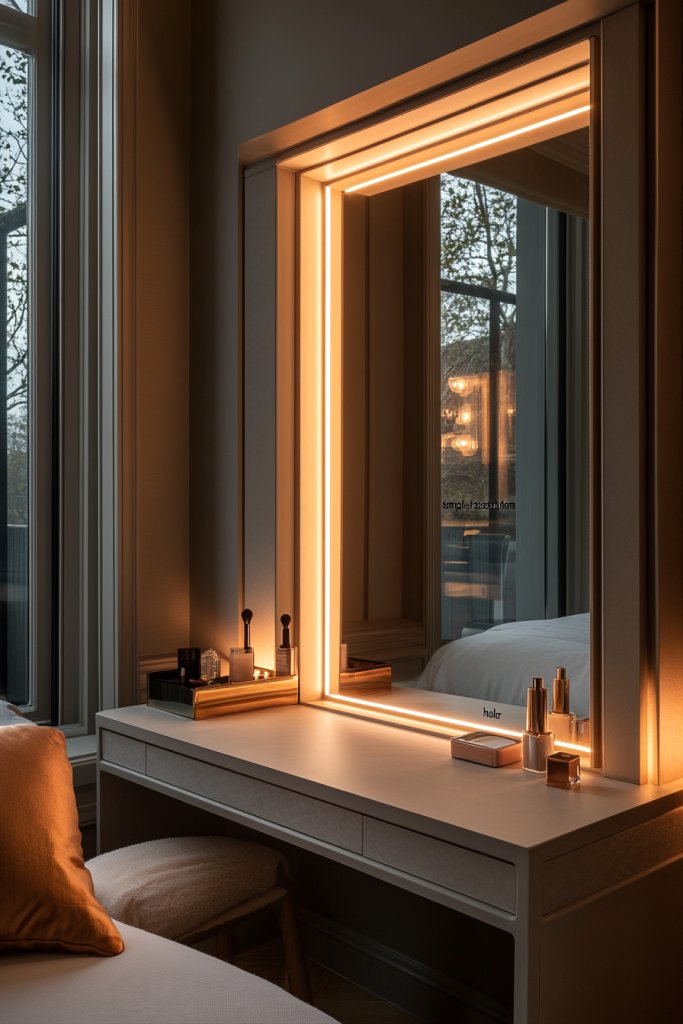
Does your morning routine feel rushed or chaotic? A well-lit vanity can make all the difference—helping you look your best and start the day calmly. Soft, warm lighting around a grey or beige framed vanity creates a relaxing space for grooming and self-care. If your current setup feels harsh or uninspiring, this upgrade can turn it into a personal sanctuary.
Imagine a sleek vanity with a matte grey or beige frame, illuminated by soft LED lights integrated into the mirror or around the edges. The gentle glow provides even, shadow-free lighting, perfect for makeup or skincare routines. The minimal design complements your bedroom decor, while the warm light enhances your skin tone and creates a cozy ambiance. The mirror’s clean lines and subtle lighting make your morning routine feel indulgent and calm.
Choose a vanity with adjustable lighting settings—warm, cool, or dimmed—to suit your mood or activity. Pair with a simple stool or chair in a neutral fabric or wood finish for comfort. For a more luxurious feel, add a textured or upholstered cushion on the seat. Keep accessories minimal—just your skincare and a few essentials—to avoid clutter and maintain serenity. Consider adding a small shelf or drawer for organized storage.
Select a vanity in a matte grey or beige finish that matches your decor style. Install LED strip lights or built-in bulbs with dimming features for adjustable brightness. Mount the mirror securely and at eye level, ensuring proper wiring for safety. Keep the surface clear of clutter—use trays or small organizers for skincare or jewelry. Regularly clean the mirror and lighting fixtures for optimal illumination. Test the lighting at different times of day to find your perfect setting.
Personalize your vanity with meaningful decor—like a textured tray for your skincare or a decorative box for accessories. Use textiles like a soft throw or a plush stool cover for added comfort. Incorporate scented candles or diffusers nearby for a calming aroma during your routine. Keep the look minimal but warm, and swap out accessories seasonally for fresh appeal. This personalized touch makes your morning routine a delightful ritual.
A well-designed vanity boosts your confidence and makes daily self-care enjoyable. Once you experience the calming glow of soft lighting, you’ll be inspired to refine other aspects of your bedroom. It’s a simple upgrade that can significantly improve your mood and start your day on a positive note. Creating a dedicated, beautifully lit space encourages consistent self-care and personal well-being.
11. Using Textured Wall Panels in Grey or Beige for Subtle Depth
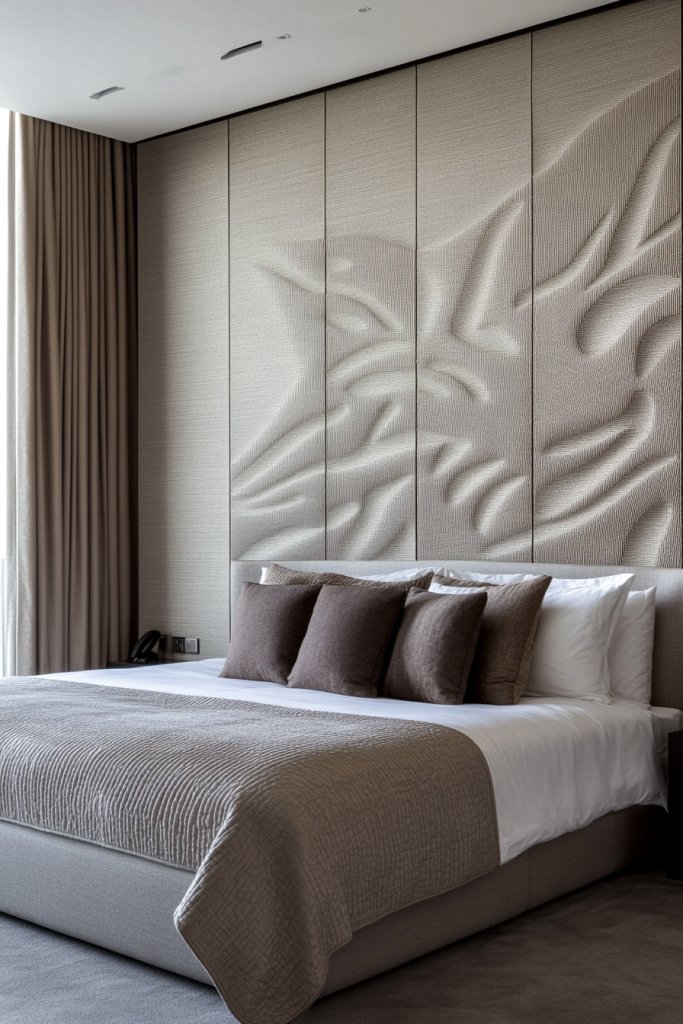
Ever walk into a bedroom and feel like something’s missing, but you can’t quite put your finger on it? The space might look calm, but it lacks that extra layer of visual interest that makes it feel complete. Sometimes, plain walls just don’t cut it when you want a cozy, sophisticated vibe. The good news? Textured wall panels in neutral tones can add that subtle depth without overwhelming the room.
Imagine running your fingers over a soft, slightly uneven surface that catches the light differently throughout the day. These panels come in gentle geometric patterns or organic textures that enhance the room’s calm palette. The muted grey or beige colors blend into the background but create a tactile experience that invites relaxation. It’s like giving your walls a gentle hug, making the space feel layered and inviting.
You can choose sleek, modern panels for a minimalist look or go for more intricate textures if you love a bit of visual drama. Seasonal tweaks might involve adding a cozy throw or layered textiles to complement the textured walls. For smaller rooms, vertical panels can make the ceiling seem higher, while horizontal layouts expand the visual width. The key is balancing texture with simplicity to keep that serene vibe.
Start by selecting panels made from lightweight materials like MDF or PVC for easy installation. Measure your wall carefully and plan the layout—consider spacing and pattern alignment. Use a strong adhesive suitable for your wall type to affix the panels securely. For a clean finish, trim any excess with a utility knife and fill gaps with neutral-colored caulk. Painting or sealing the panels beforehand can add longevity and a seamless look. If DIY isn’t your thing, hiring a professional ensures perfect placement.
Add personalized touches by choosing panels with subtle patterns that reflect your style—think gentle waves, geometric lines, or organic shapes. Incorporate textured wall panels alongside soft textiles, like a plush headboard or layered curtains, for a cozy, layered effect. You could also highlight one accent wall with a different texture to create a focal point. Playing with light and shadow on the textured surface further enhances the depth.
Textured wall panels transform a bland bedroom into a sanctuary of calm and style. They’re a subtle upgrade that’s both functional and decorative, perfect for those who love understated elegance. With a bit of effort, you can achieve a designer-quality result that feels uniquely yours. Ready to give your walls that sophisticated touch? Your serene bedroom awaits a touch of textured magic.
12. Incorporating Monochrome Art Prints in Grey and Beige for Sophistication

Ever feel like your bedroom needs a splash of personality but you’re wary of clashing colors or overwhelming patterns? Monochrome art prints in shades of grey and beige offer a subtle way to elevate your space without sacrificing the calming vibe. They add a layer of sophistication and visual interest that’s easy to update or change.
Picture sleek, black-and-white photographs or abstract grey-toned sketches adorning your walls. These prints create a cohesive look that complements your neutral palette while injecting personality. The subtle contrast draws the eye without disrupting serenity. Imagine waking up to a calming landscape or a minimalist geometric design that sets the tone for a peaceful day.
Mix different styles—like a series of black-and-white photographs or tonal sketches—to create a gallery wall that feels curated yet effortless. For seasonal updates, swap prints with different themes or frame them with matte finishes in matching neutral tones. Larger prints can serve as focal points, while smaller pieces add nuanced detail. This approach works well in both modern and rustic bedrooms.
Select prints in high-quality paper or canvas with neutral frames—think matte black, grey, or beige—to keep everything cohesive. Hang them at eye level, spacing evenly for a balanced look. Use painter’s tape or picture hanging strips for easy placement without damaging your walls. For a more polished look, consider creating a grid or linear arrangement. Rotate or update prints seasonally to keep the space fresh without much effort.
Personalize your monochrome art by choosing images that resonate with your personality—like favorite cityscapes, abstract designs, or botanical sketches (minus the plants, of course). Incorporate textured mats or double mats for depth. Combine different framing styles for an eclectic yet cohesive effect. You can also add small sculptural elements on shelves that echo the minimalist aesthetic.
Monochrome art is timeless and versatile, perfect for creating a chic, serene retreat. It’s an easy way to add sophistication without clutter or chaos. With simple frames and strategic placement, you can craft a gallery that feels curated and intentional. Ready to elevate your bedroom’s style with subtle, impactful art? Confidence comes from knowing less is more.
13. Adding a Beige or Grey Upholstered Ottoman at the Foot of the Bed
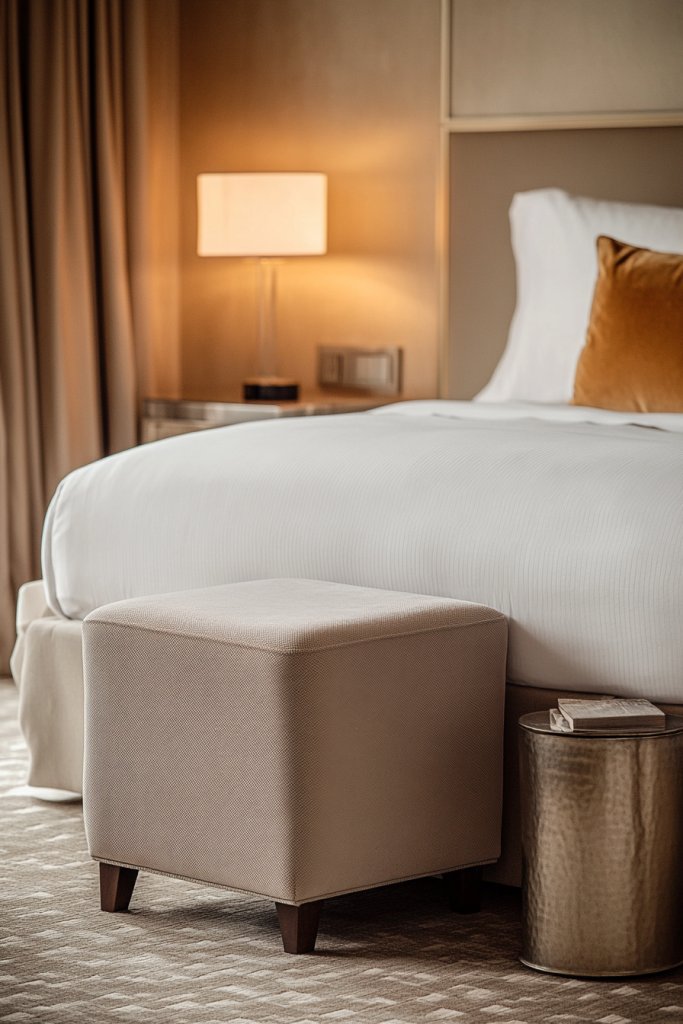
Ever find yourself wishing for a bit of extra comfort or a handy surface to toss your clothes or throw blankets? An upholstered ottoman in beige or grey at the foot of your bed solves this dilemma with style. It’s both functional and adds a plush touch to your bedroom’s overall look.
Imagine sinking into a soft, cushioned ottoman covered in a textured fabric that matches your color palette. It’s a cozy spot for putting on shoes, laying out clothes, or just stretching out after a long day. The neutral tones blend seamlessly with your bedding and furniture, creating a harmonious, inviting atmosphere. This piece instantly elevates the room’s comfort level and visual appeal.
Opt for tufted or sleek minimalist styles depending on your vibe. Larger ottomans can double as extra seating for guests or a place to display decorative trays or books—if you’re into that sort of thing. For seasonal flair, swap out the cover fabric or add a cozy throw blanket. You can also choose a storage ottoman if you need hidden space for extra linens or accessories.
Pick an ottoman that complements your bed size—proportion matters! Look for sturdy frames and soft, durable upholstery in neutral tones like beige linen or grey velvet. Place it centrally at the foot of your bed, ensuring it doesn’t block pathways or access to other furniture. If you want a tailored look, add decorative stitching or piping. For extra comfort, add a cushion or small throw on top.
Personalize with decorative pillows or a textured throw that coordinates with your bedding. Use it as a base for stacking your favorite blankets or seasonal accessories. You can also customize the fabric to match your room’s style—think plush chenille or sleek faux leather. This piece can truly reflect your personality while remaining practical.
An upholstered ottoman is more than just a piece of furniture; it’s a cozy retreat within your room. It adds softness and invites relaxation while serving a practical purpose. Once you choose a versatile neutral tone, it becomes a timeless addition that enhances your bedroom’s overall serenity. Ready to make your space more functional and comfy? It’s a game-changer!
14. Using Soft, Neutral-Colored Bedding with Minimalist Design for Restful Sleep
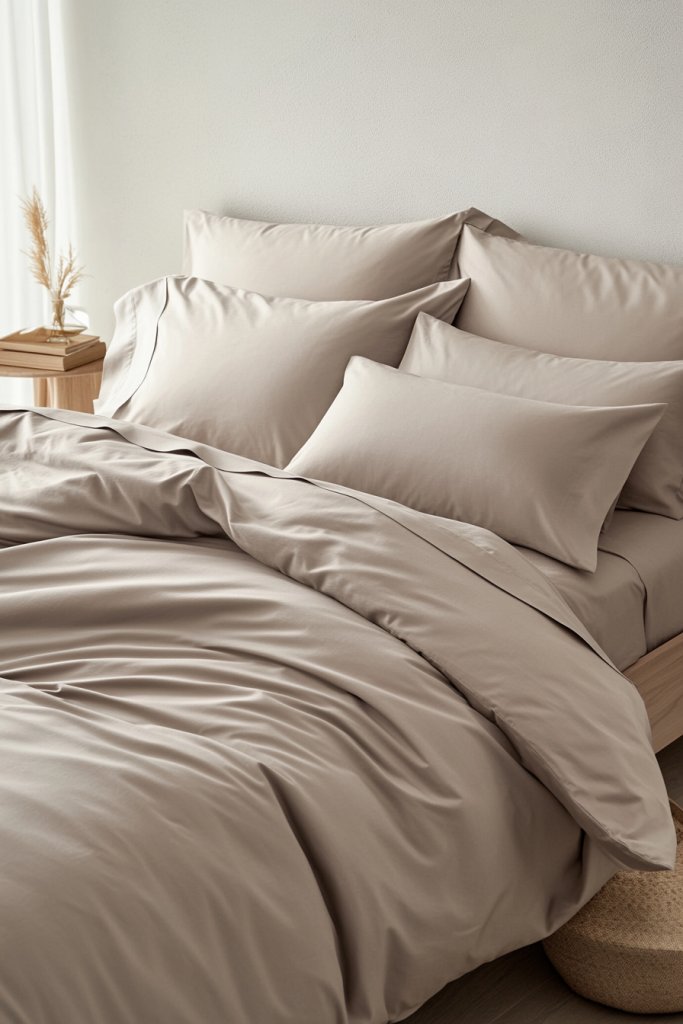
Do you ever lie in bed feeling like your sleep environment is just a bit off? Cluttered, overly busy bedding can make it hard to relax fully. The solution? Opting for soft, neutral-colored bedding with a minimalist design creates a peaceful sanctuary that promotes restful sleep. It’s about stripping away distractions for true relaxation.
Picture a bed dressed in smooth, creamy sheets paired with a simple duvet cover in a soft taupe or light grey. The pillows are neatly arranged with matching cases, and the entire bed exudes calmness. The muted tones reflect ambient light softly, making the room feel expansive and serene. The textures are subtle—cotton, linen, or sateen—inviting touch and comfort.
Choose bedding with clean lines and minimal patterns—think solid colors or very subtle tonal stripes. For different seasons, layer with textured throws or lightweight blankets in similar hues. You can also add decorative pillows with textured or embroidered details for a bit of visual interest without cluttering the look. This approach suits both small and large bedrooms.
Select high-quality, breathable fabrics like linen or cotton for comfort and durability. Keep the color palette simple—stick to shades of beige, grey, or cream. Use high-thread-count sheets for a luxurious feel that promotes better sleep. Make sure your bedding fits well without bunching or excess fabric. A tidy, well-made bed instantly elevates the room’s calming ambiance. Wash regularly to maintain softness and freshness.
Add a personal touch with a textured bed runner or subtle piping that echoes your style. Incorporate a few plush pillows in coordinating shades for layered comfort. Opt for a simple headboard or wall-mounted panel to keep the focus on the bedding’s serenity. Keep accessories minimal—less clutter equals better sleep.
Choosing minimalist, neutral bedding transforms your bedroom into a sleep haven that feels both luxurious and calming. It’s a simple upgrade that encourages relaxation and improves sleep quality. When your bed looks this peaceful, waking up becomes a little easier. Ready to embrace the art of restful simplicity? Your best sleep awaits.
15. Installing a Ceiling-Mounted Light Fixture in Matte Grey or Neutral Finish
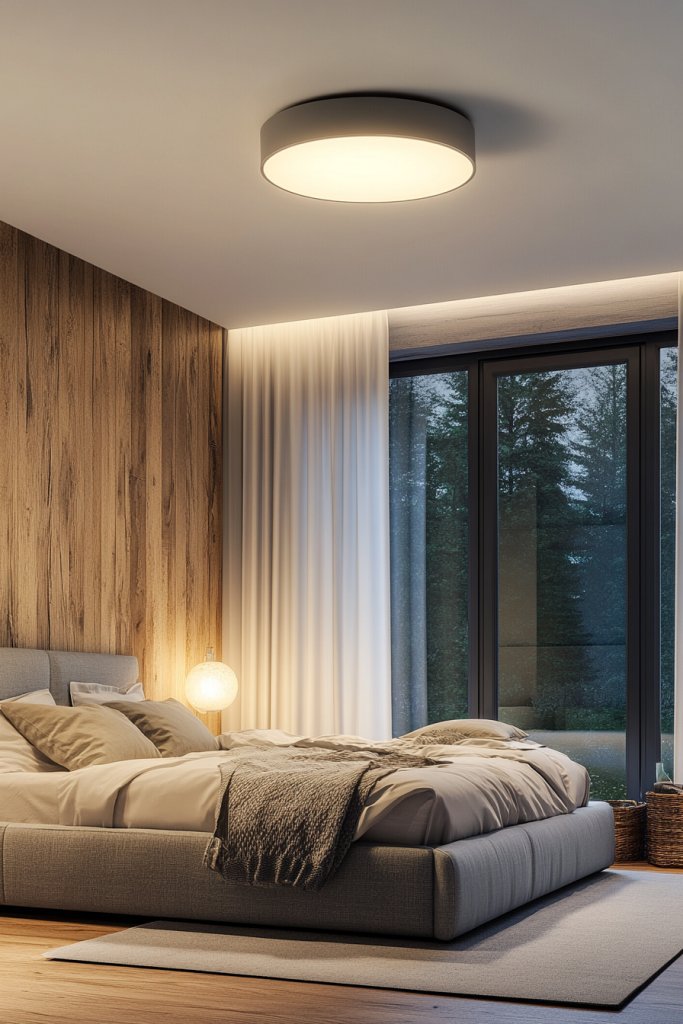
Ever tried creating a calming bedroom but felt overwhelmed by the sheer number of lighting options? Sometimes, the fixtures you choose can make or break the entire vibe. You want something that adds softness without stealing attention or feeling out of place. Finding the perfect ceiling light that blends seamlessly can be a real challenge, especially if you aim for that serene, understated look.
Imagine a sleek, matte grey ceiling fixture hanging quietly in the center of your room. Its rounded shape softly diffuses warm white light, casting a gentle glow across neutral-colored walls. The fixture’s smooth finish complements the calming palette, while its minimalist design keeps the focus on tranquility. Soft shadows dance on the ceiling, creating a cozy, inviting atmosphere perfect for unwinding after a long day. It’s like a quiet anchor that ties the entire space together without overpowering it.
Opt for dimmable fixtures to adjust brightness for different moods or seasons. For a more modern vibe, choose a geometric or sculptural shape; for a softer look, go for rounded or organic forms. In smaller rooms, a single minimalist fixture works best, while larger bedrooms can handle a layered approach with multiple fixtures. You can also swap warm white bulbs for cooler tones during summer months for a fresh feel. The key is selecting a neutral finish that complements your overall decor style.
Start by measuring your ceiling height to ensure the fixture hangs at the right level—about 7 feet above the floor for standard rooms. Choose a fixture in matte grey or a neutral tone that matches your palette. Use a sturdy ceiling mount with compatible wiring, and consider hiring an electrician if you’re not comfortable with electrical work—safety first! Attach the fixture securely, then install a compatible dimmer switch to control ambiance. Test the lighting at different levels to find your ideal glow before finalizing the setup. Remember, simple installations often look the most elegant.
Personalize your fixture by adding a decorative trim or choosing a unique bulb shape that mimics vintage Edison styles. Consider installing a ceiling medallion in a matching neutral tone for a subtle decorative touch. You could also pair it with wall sconces or indirect lighting for layered illumination—just avoid cluttering the ceiling with too many fixtures. The goal is to keep the look sleek, functional, and tailored to your comfort level. Small tweaks can make a big impact on overall serenity.
A well-chosen ceiling fixture sets the tone for a peaceful sanctuary. Knowing you’ve picked something simple yet stylish gives you confidence to enhance other areas of your bedroom. Plus, with modern dimming options, you can easily adjust the mood—bright for mornings, soft for evenings. Ready to elevate your calming space with a sleek, matte grey fixture? It’s a small detail that makes a big difference in your daily relaxation routine.
16. Incorporating Subtle Metallic Accents in Silver or Brushed Nickel
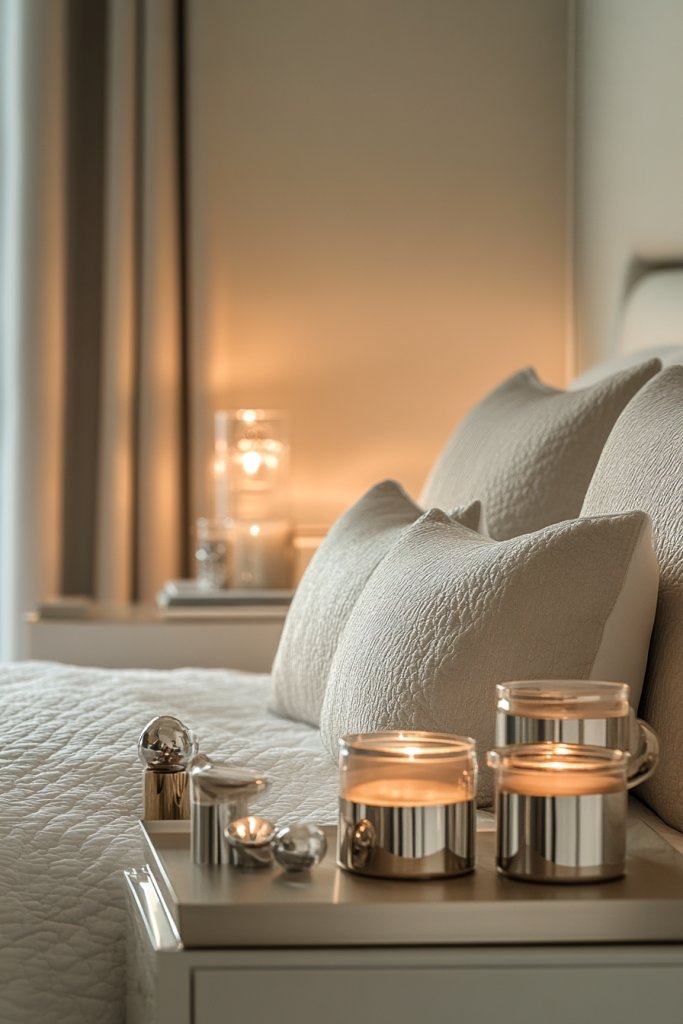
Looking to add a touch of elegance to your bedroom without overwhelming the peaceful vibe? Metallic accents are a subtle way to elevate your space, but the trick is keeping them understated. Overdoing shiny finishes can turn a serene retreat into a showroom, so finding the right balance is key. You want that hint of sophistication that catches the eye just enough to impress.
Visualize soft silver drawer pulls that catch the light when you open your dresser. Maybe a brushed nickel finish on your door handles, blending seamlessly into the neutral backdrop. Small metallic details on furniture edges or decorative trims subtly reflect light, adding depth without distraction. These accents create a refined, polished look that complements the calm, neutral palette. The metallic gleam offers a quiet luxury that feels both modern and timeless, elevating your bedroom’s overall aesthetic.
Mix and match metallic finishes for an eclectic yet cohesive feel—pair matte silver with brushed nickel for subtle contrast. Use metallic accents sparingly on hardware, picture ledges, or decorative trims to avoid visual clutter. Seasonal updates can include swapping darker hardware for brighter finishes during summer to keep the space lively. For a more classic look, choose simple, clean-lined metallic fixtures, while more contemporary styles might feature geometric shapes with metallic detailing. The key is harmony and restraint.
Select hardware in silver or brushed nickel finishes that match your existing fixtures or furniture accents. Measure and plan placement carefully, whether on drawers, cabinet doors, or light fixtures. When installing, tighten screws securely but avoid over-tightening, which can damage delicate finishes. For small decorative items, consider using metallic adhesive strips or paint for DIY updates. Regularly clean metallic surfaces with a soft cloth to prevent tarnish and keep the shine subtle. Layering small accents thoughtfully creates a sophisticated, calming effect.
Add personal flair by choosing unique metallic knobs or decorative trims with subtle patterns. Incorporate small metallic sculptures or sculptural handles to introduce texture and visual interest. You can also pair metallic accents with textured textiles like velvet or linen to create contrast. For a cohesive look, ensure all metallic elements follow a similar finish or tone—consistent metallicity enhances serenity without chaos. These details give your bedroom a curated, elegant feel.
Using metallic accents is a simple way to boost your bedroom’s style quotient without overwhelming the calm aesthetic. When thoughtfully integrated, they reflect light softly and add a layer of sophistication. This effortless elegance can inspire you to experiment with other subtle decor upgrades. Trust your eye for balance—sometimes, a tiny metallic detail is all you need to turn a plain space into a refined retreat. Embrace the understated luxury and enjoy your tranquil, stylish sanctuary.
17. Creating a Cozy Nook with Beige or Grey Armchair and Soft Throw Blanket
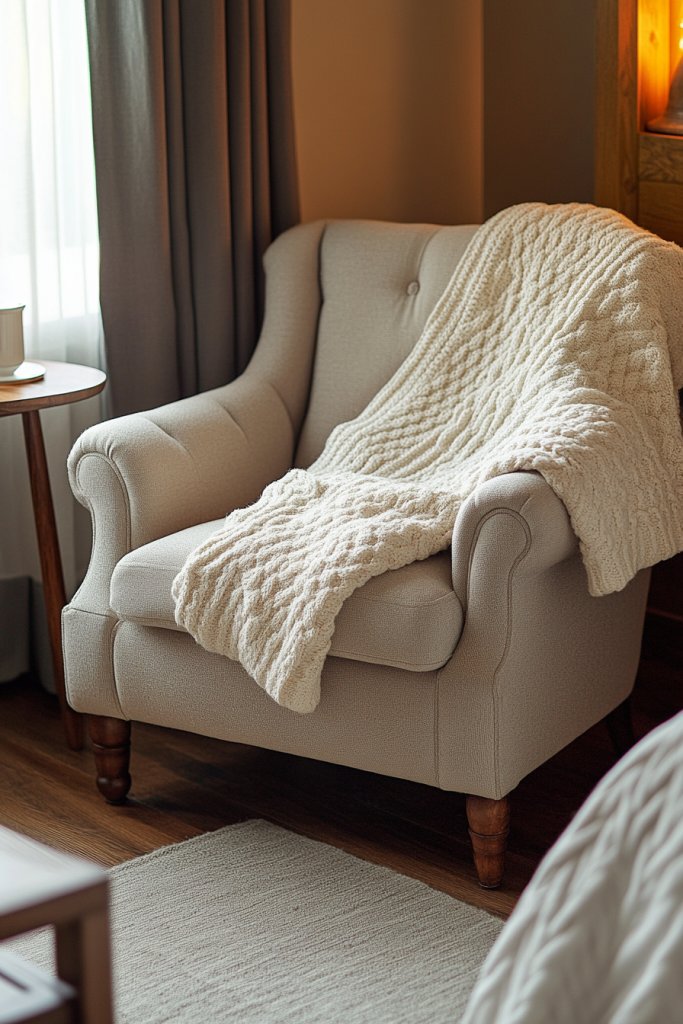
Ever wish your bedroom had a little corner just for relaxing with a book or unwinding after a hectic day? Creating a cozy nook is a perfect way to add functional comfort without cluttering your space. The challenge is designing it so it feels inviting and blends seamlessly with your calming palette. Who says you need a whole room to enjoy a personal retreat?
Picture a plush beige armchair nestled beside a softly textured throw blanket, draped over one arm. A small side table in neutral wood or matte finish holds a cup of tea or your favorite mug—no vases or art necessary. The corner is softly lit by a wall sconce or indirect lighting, emphasizing comfort. Warm textiles and gentle hues make it irresistible to curl up in, turning a quiet corner into your personal escape. This setup transforms your bedroom into a retreat that’s both functional and soothing.
Choose an armchair with a rounded silhouette for a more inviting look or a sleek, modern style for minimalism. Layer the space with textured throws, cushions, or a small woven rug to increase warmth. During colder months, swap out lightweight textiles for thicker, plush options. For smaller bedrooms, opt for a compact reading chair or even a pouf that doubles as seating. Incorporate personal touches like a small bookshelf or a stack of your favorite magazines within arm’s reach. Flexibility is key to making this nook truly yours.
Select an armchair in neutral tones like beige, grey, or taupe that complements your overall palette. Add a soft throw blanket in a contrasting or matching textured fabric, such as chunky knit or plush fleece. Position the chair near a power outlet if you want to add a small reading lamp, but avoid bulky lighting fixtures—stick with wall sconces or clip-on lamps. Use a small side table that fits your space, ensuring it’s sturdy and in harmony with the chair. Keep the area clutter-free, and consider adding a few personal items to make it feel cozy and lived-in.
Personalize your nook with cushions in different textures or subtle patterns that align with your color scheme. Incorporate a soft, layered textile scheme—think a lightweight quilt or textured pillow covers—that invites touch. Add a small, foldable storage ottoman nearby for extra blankets or reading material. If space allows, hang a neutral-toned textile or a woven wall hanging for visual interest without breaking the calming vibe. The goal is to craft a space that feels both relaxing and uniquely yours.
A cozy nook turns a simple bedroom corner into your favorite retreat. It encourages daily moments of calm, making your space more functional and welcoming. When you see how small details like textiles and furniture choices transform a corner into a sanctuary, you gain confidence to explore other personal touches. Ready to create your own peaceful hideaway? Just pick your favorite neutrals and cozy textiles—you’re all set for a perfect retreat within your bedroom.
Conclusion
Error generating conclusion.
Leave a Reply